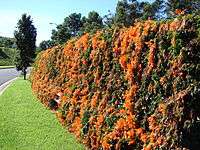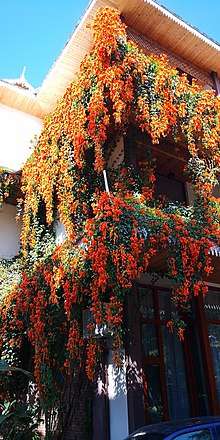Pyrostegia venusta
Pyrostegia venusta, also commonly known as flamevine[2] or orange trumpetvine, is a plant species of the genus Pyrostegia of the family Bignoniaceae originally endemic to southern Brazil, Bolivia, northeastern Argentina and Paraguay, but now a well-known garden species.[3][4] The species was first described by John Miers in 1863.
| Pyrostegia venusta | |
|---|---|
| Scientific classification | |
| Kingdom: | |
| (unranked): | |
| (unranked): | |
| (unranked): | |
| Order: | |
| Family: | |
| Genus: | |
| Species: | P. venusta |
| Binomial name | |
| Pyrostegia venusta | |
| Synonyms[1] | |
| |
Etymology


"Pyrostegia" from the Greek pyros means 'fire', relating to the colour of the flowers and the shape of the upper lip, and stegia means 'covering'. When the flowers cover the roof, it looks like it's on fire. Venusta means 'beautiful', 'charming', or 'graceful'.[5]
Description
It is an evergreen, vigorously expanding climber that reaches up to 5 m in height. The foliage is made up of green leaves that have 2 to 3 leaflets, opposite, 4 to 8 cm long and with 3-branched tendrils.[6]
The orange flowers, which appear from winter to spring, are arranged in dense bouquets and are 5 to 9 cm long. They are pollinated by hummingbirds. The fruits are smooth 3 dm long brown capsules.
Cultivation
The plant is very sensitive to cold winds and prefers sunny, sheltered locations. Frost hardiness zones is 9–11. It is resistant to soil salinity. The plant has powerful twiners which will cling to almost anything, including bare brick walls. It is a very fast grower and therefore should be pruned to forestall it from growing out of control and suffocating proximate plants. It can be grown from semi-hardwood cuttings taken in summer, autumn or winter.
It is naturalised in eastern Australia, eastern Africa and south-eastern USA.[7]
References
- The Plant List: A Working List of All Plant Species, retrieved 8 September 2016
- "Pyrostegia venusta". Natural Resources Conservation Service PLANTS Database. USDA. Retrieved 16 October 2015.
- Proceedings of the Royal Horticultural Society of London 3:188. 1863
- "Pyrostegia venusta". Germplasm Resources Information Network (GRIN). Agricultural Research Service (ARS), United States Department of Agriculture (USDA). Retrieved 7 October 2006.
- Gledhill, David (2008). "The Names of Plants". Cambridge University Press. ISBN 9780521866453 (hardback), ISBN 9780521685535 (paperback). pp 322, 399
- Orange Trumpet Creeper by Burke's Backyard
- Pyrostegia venusta by Weeds of Australia - Biosecurity Queensland Edition
External links
